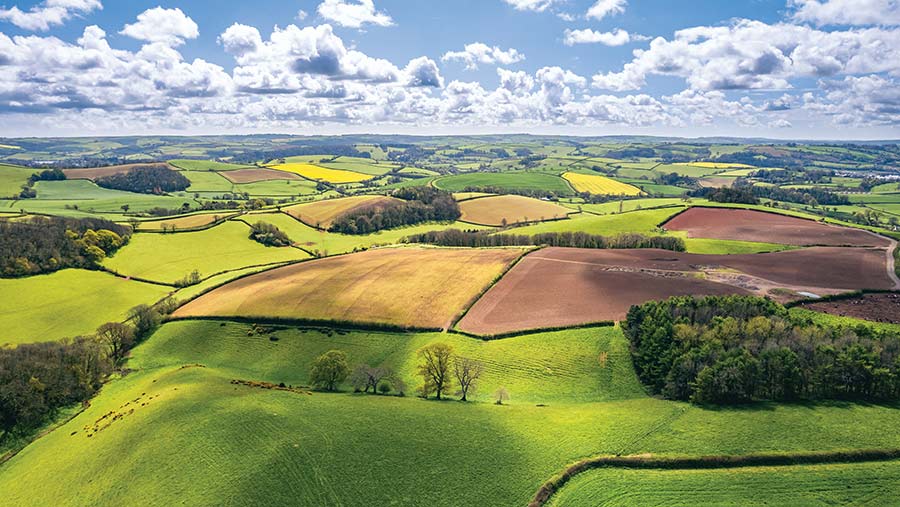Pressure on councils poses threat to smallholdings estates
 © Maciej Olszewski/Adobe Stock
© Maciej Olszewski/Adobe Stock Defra’s annual report on county council farms in England shows relatively little change in overall land holdings, but growing pressures on authorities are influencing decisions.
Acquisitions and disposals resulted in a decrease of just 0.6% in the area of land held by the 26 local authorities which provided information on this aspect.
Across those 26 authorities, the smallholding estates total was 157,284 acres. There are 43 local authorities with farming estates.
See also: Changes to farm tenancy succession what you need to know
Defra smallholdings survey 2022
- 27 authorities provided data, owning and letting 1,958 smallholdings at 31 March 2022
- About £21m in smallholding rents was due to the 24 authorities that provided financial information
- Average rent was just under £135/acre, with those on equipped farms averaging 12.5% higher than for bare land lettings
- The 27 authorities that provided data had 1,396 tenants at 31 March 2022
- In 2021-22, those authorities granted 85 tenancies, while 99 tenancies ended
- New tenants took on 34 of the tenancies granted on equipped farms, first time entrants to the individual estate and who had not previously occupied a council farm
- County smallholdings produced a net surplus of £12.12m for the 22 authorities which provided complete financial information to the survey
Broader approach
Tenant Farmers Association chief executive George Dunn said a more co-ordinated and broader management approach was needed to give a national perspective to local authority farmland.
“Although there have not been big changes in the past year, there is still a lot of internal pressure,” he said.
“Holdings have to have access to capital funding to properly equip them for the productivity gains that are needed.”
Financial pressure and planning policy changes mean authorities are looking at their farming estates for solutions.
Peterborough City Council is in the process of selling off its farms in response to financial challenges.
Its rural estate covers about 2,965 acres of Grade 2 and 3 arable land. Initially, these are being offered to sitting tenants.
Planning changes include the requirement for developers to deliver a minimum 10% biodiversity net gain (BNG) from November this year, alongside the immediate need for nutrient mitigation measures to combat high phosphate and nitrogen levels in many catchments. Both will require farmland.
“We haven’t seen pressure on sitting tenants in this respect, but on vacant land local authorities are taking the opportunity of either BNG or nutrient neutrality,” George said.
“Wiltshire County Council has taken a sizeable acreage out of agricultural production for the long term for nutrient mitigation, and I suspect we will find similar action taken for biodiversity net gain.
“Our concern is what that does for the fabric of the tenanted sector. The government has said its objective is not to diminish the sector.
“Development must look at how to internalise that rather than offset 30 or 40 miles away, otherwise there is a risk of no public benefit and of lowering capacity in the tenanted sector.”
BNG county farm
Cambridgeshire has the largest local authority farming estate in England, at 33,000 acres and more than 160 tenants.
It received more than 40 applications for holdings to let in 2022, with seven new tenants taking on farms.
It has earmarked a 346-acre farm as a BNG land bank, describing this as a vital missing link in a chain of strategic environmental sites.
Trees and hedges are being planted at scale and arable land is being reverted to grass, with the aim of establishing chalk grassland.
This will be let to a tenant for grazing and to manage the newly established chalk grassland.
Type of smallholdings tenancy by percentage |
|
Tenancy term |
% of tenancies |
|
Lifetime |
18.9 |
|
Retirement |
10.2 |
|
Farm Business Tenancy (FBT) less than five years |
17.5 |
|
FBT five to 10 years |
18.6 |
|
FBT 10 to 15 years |
15.4 |
|
FBT more than 15 years |
19.4 |
|
Source: Defra 72nd annual report to Parliament on smallholdings in England, 1 April 2021 to 31 March 2022, published 26 July 2023 Note: equipped and bare land farms only, for the 26 authorities that provided tenancy information |
|
